July 27th, 2018 by
Weeds are a nuisance that everyone has to deal with at some point. They can make your garden and home look unsightly and could even harm its value if you can’t get rid of them when you try to sell. Some weeds are worse than others, though, and here in the UK, we have several types of weeds that are actually dangerous. Some of these weeds are so harmful to people, animals, and native plants that they’re actually controlled by the government. In fact, allowing any of these weeds to spread to the wild is against the law and can carry a maximum prison sentence of up to 2 years! There’s no need to worry, though. It’s not an offence to have these weeds growing on your land, so as long as you make sure to dispose of them properly you won’t be in any trouble. We’ll walk you through these harmful weeds, how you can identify them, and how you can get rid of them.
Giant Hogweed
 Note the thick, bristly stems and cluster of white flowers A striking plant that you can identify thanks to its tall, thick stems and white blooms, giant hogweed is considered the UK’s most dangerous weed. You can generally see giant hogweed growing from spring through to autumn.
Note the thick, bristly stems and cluster of white flowers A striking plant that you can identify thanks to its tall, thick stems and white blooms, giant hogweed is considered the UK’s most dangerous weed. You can generally see giant hogweed growing from spring through to autumn.
Why is Giant Hogweed Dangerous?
Giant hogweed is known for its sap, which is incredibly dangerous as it causes the skin to become very sensitive to sunlight. This means, if it gets on your skin, just going outside puts you at risk of severe burns. We wrote about the problems caused by giant hogweed in more detail here, so make sure you give that blog entry a read if you’re concerned.
How to Get Rid of Giant Hogweed
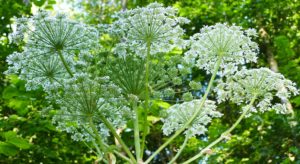 You can pull hogweed up while the plant is still young, but beware of its sap As with most of the weeds on this list, glyphosate weedkiller is your best bet. This means you can kill the weed and its roots without having to get too close. If you like, you can dig out giant hogweed by hand, although you must make sure you get under the root to make sure the plant doesn’t come back. If you do dig up giant hogweed, dispose of it either by burning, composting in a secure container, or taking it to a licenced controlled waste tip.
You can pull hogweed up while the plant is still young, but beware of its sap As with most of the weeds on this list, glyphosate weedkiller is your best bet. This means you can kill the weed and its roots without having to get too close. If you like, you can dig out giant hogweed by hand, although you must make sure you get under the root to make sure the plant doesn’t come back. If you do dig up giant hogweed, dispose of it either by burning, composting in a secure container, or taking it to a licenced controlled waste tip.
Creeping Thistle
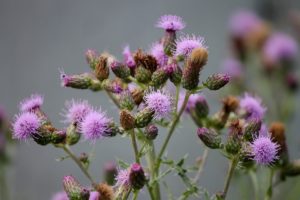 Creeping thistle is well-known for its colourful flowers A well-known and easily-recognisable weed, creeping thistle is identifiable by its spiny leaves and, in summer, its pretty pink flowers. It’s a perennial weed, so you can find creeping thistle at virtually any time of year.
Creeping thistle is well-known for its colourful flowers A well-known and easily-recognisable weed, creeping thistle is identifiable by its spiny leaves and, in summer, its pretty pink flowers. It’s a perennial weed, so you can find creeping thistle at virtually any time of year.
Why is Creeping Thistle Dangerous?
It might be pretty to look at when the flowers bloom over the summer, but creeping thistle is an aggressively invasive weed that’ll take over your garden if you let it. It can spread through both seeds and by spreading its roots underground, so creeping thistle can quickly dominate flowerbeds and lawns, killing off your other plants as it competes for water and light. What really makes creeping thistle dangerous, though, is its infamous spiky leaves. These pose a real threat to children and animals especially, as tumbling into a bed of thistles will leave them covered in scratches. These scratches tend to be quite itchy and irritating, meaning it can be hard to resist scratching them, putting the victim at risk of infection.
How to Get Rid of Creeping Thistle
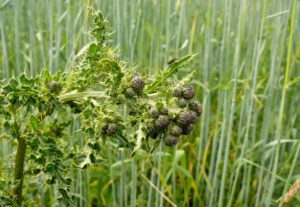 Watch out for the spiky leaves when removing thistles The quickest and easiest way is to pick up some glyphosate weedkiller which will kill the plant and its roots. This also means you don’t have to touch the thistle, which means you’re not going to accidentally cut yourself. Non-chemical control of thistles is difficult as thistle roots tend to fragment as you dig them out of the ground, meaning they can regenerate quickly, so weedkiller is definitely the way to go here.
Watch out for the spiky leaves when removing thistles The quickest and easiest way is to pick up some glyphosate weedkiller which will kill the plant and its roots. This also means you don’t have to touch the thistle, which means you’re not going to accidentally cut yourself. Non-chemical control of thistles is difficult as thistle roots tend to fragment as you dig them out of the ground, meaning they can regenerate quickly, so weedkiller is definitely the way to go here.
Common Ragwort
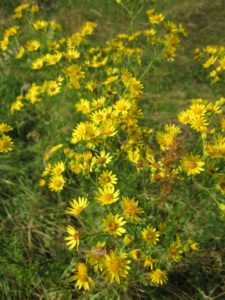 Common ragwort is found everywhere An extremely common weed, common ragwort can be identified by its small yellow flowers that look a bit like daisies. The stem also produces a lot of light, droopy leaves that look like large rocket leaves.
Common ragwort is found everywhere An extremely common weed, common ragwort can be identified by its small yellow flowers that look a bit like daisies. The stem also produces a lot of light, droopy leaves that look like large rocket leaves.
Why is Common Ragwort Dangerous?
Common ragwort isn’t really that dangerous to people, but it’s classed as a harmful weed by the government because of the risk it poses to livestock. Ragwort is poisonous, meaning grazing animals and even certain pets like rabbits will fall ill if they eat too much of it. While common ragwort is toxic to humans as well, you do have to ingest large amounts of it to feel the effects, so don’t worry if you have a curious toddler that likes to try putting random things in their mouth!
How to Get Rid of Common Ragwort
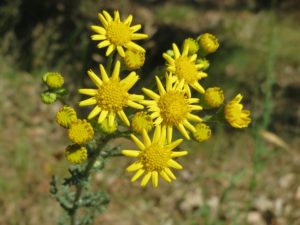 Identify ragwort by its daisy-like yellow flowers Non-chemical control methods don’t really work with common ragwort as cutting them down actually encourages it to grow even more. Pulling them out of the ground isn’t effective either as you’ll be left with bits of root in the earth which can quickly grow into new plants. That means you need to turn to your trusty glyphosate weedkiller to get the job done once again, ensuring you kill both the root and the plant.
Identify ragwort by its daisy-like yellow flowers Non-chemical control methods don’t really work with common ragwort as cutting them down actually encourages it to grow even more. Pulling them out of the ground isn’t effective either as you’ll be left with bits of root in the earth which can quickly grow into new plants. That means you need to turn to your trusty glyphosate weedkiller to get the job done once again, ensuring you kill both the root and the plant.
New Zealand Pigmyweed
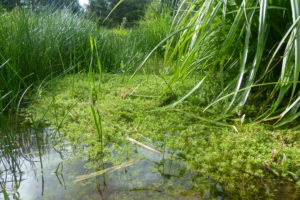 New Zealand Pigmyweed quickly takes over pools of water - By Benjamin Blondel - Own work, CC BY-SA 4.0, https://commons.wikimedia.org/w/index.php?curid=43919562 An aquatic plant, New Zealand pigmyweed was introduced to the UK as a feature for garden ponds. It’s a pretty, rustic-looking plant with long stems, small, green leaves and dainty white flowers. However, the New Zealand pigmyweed poses a threat to British wildlife which saw it banned from sale in 2014.
New Zealand Pigmyweed quickly takes over pools of water - By Benjamin Blondel - Own work, CC BY-SA 4.0, https://commons.wikimedia.org/w/index.php?curid=43919562 An aquatic plant, New Zealand pigmyweed was introduced to the UK as a feature for garden ponds. It’s a pretty, rustic-looking plant with long stems, small, green leaves and dainty white flowers. However, the New Zealand pigmyweed poses a threat to British wildlife which saw it banned from sale in 2014.
Why is New Zealand Pigmyweed Dangerous?
This particular plant is incredibly invasive and will quickly grow long stems across garden ponds or seasonal pools. These stems grow so aggressively that they tangle up inside the pond, forming impenetrable barriers and trapping or suffocating wildlife in the water. This also presents a risk to pet owners who could see their pets slip into the pond and get tangled up in the pigmyweed.
How to Get Rid of New Zealand Pigmyweed
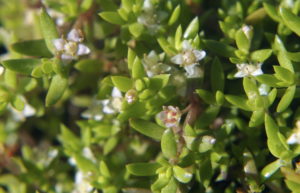 New Zealand Pigmyweed has small white flowers and long stems - By ashley BALSAM baz (Flickr) [CC BY 2.0 (https://creativecommons.org/licenses/by/2.0)], via Wikimedia CommonsAgain, a good glyphosate weedkiller like Roundup is your best bet, however, New Zealand pigmyweed is a little more awkward than most weeds. This is because it grows so vigorously, quickly forming dense mats inside shallow bodies of water, which means it can take a lot of weedkiller to get the job done as it’ll dilute in the water. This means you may need to completely empty your pond before applying the weedkiller. Naturally, this means you need to start treating New Zealand pigmyweed as soon as you possibly can before it completely takes over your pond.
New Zealand Pigmyweed has small white flowers and long stems - By ashley BALSAM baz (Flickr) [CC BY 2.0 (https://creativecommons.org/licenses/by/2.0)], via Wikimedia CommonsAgain, a good glyphosate weedkiller like Roundup is your best bet, however, New Zealand pigmyweed is a little more awkward than most weeds. This is because it grows so vigorously, quickly forming dense mats inside shallow bodies of water, which means it can take a lot of weedkiller to get the job done as it’ll dilute in the water. This means you may need to completely empty your pond before applying the weedkiller. Naturally, this means you need to start treating New Zealand pigmyweed as soon as you possibly can before it completely takes over your pond.
Comments
Leave a reply
Your e-mail address will not be published. All fields are required


